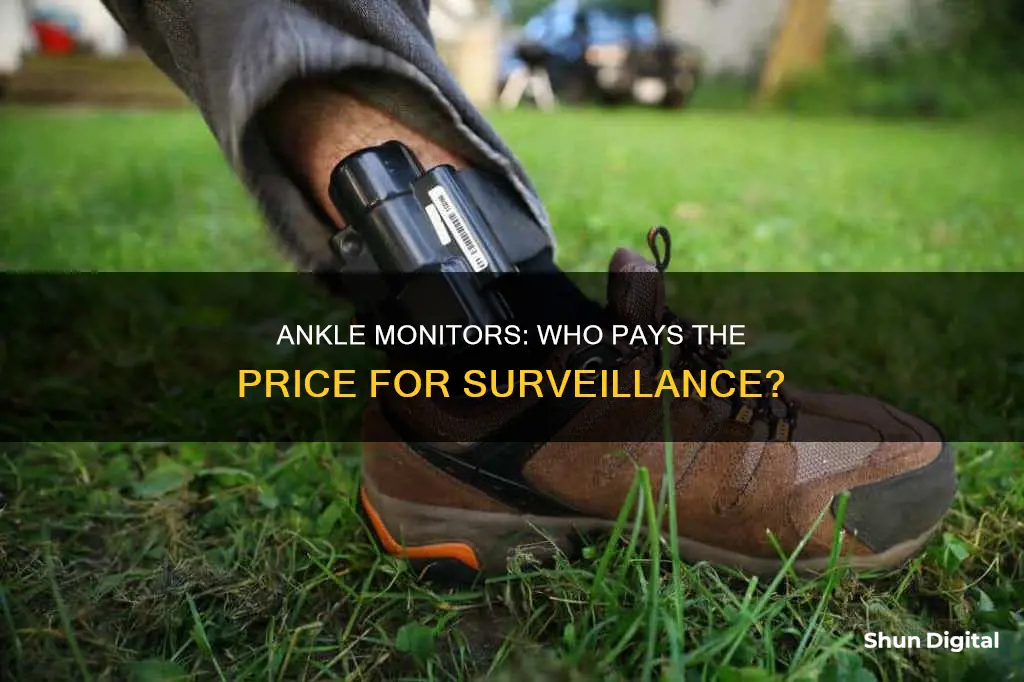
Ankle monitors are often used as an alternative to jail time for first-time and non-violent offenders. They are also used to monitor those on house arrest, bail, or probation. The wearer typically has to pay for the cost of the monitor, including a daily use fee and a setup fee. The cost of an ankle monitor is significantly lower than the cost of incarceration, with house arrest costing about $6,000 per year compared to over $20,000 per year for prison. However, for those who cannot afford the cost, ankle monitors can lead to debt and even incarceration. While ankle monitors are promoted as a more humane alternative to jail, there are concerns about the financial burden they place on individuals, particularly those from low-income backgrounds.
| Characteristics | Values |
|---|---|
| Cost | Hundreds of dollars to install and hundreds of dollars per month for monitoring services |
| Payment | The wearer usually has to pay for the cost of the monitor, with a daily use fee. Some court systems charge on a sliding scale based on income and ability to pay. |
| Purpose | An alternative to jail time, used for house arrest, alcohol monitoring, or bail pending a trial |
| Waterproof | Yes, but the level of water resistance can vary |
| Tracking | Not just for tracking movements, they can also test your sweat and detect the level of alcohol in your body |
| Alert | If you go outside a specific perimeter, the monitor will alert the monitoring station |
| Removal | Removal of a court-ordered ankle monitor is a third-degree felony |
What You'll Learn

Cost of ankle monitors
The cost of an ankle monitor varies depending on the state, the company providing the device, and the individual's income and ability to pay. In most states, the wearer of the ankle monitor is required to pay daily, weekly, monthly, or flat fees for the device and monitoring services. These fees can range from $5 to $15 per day, plus a setup fee of up to $200. Some court systems may also charge a sliding scale based on income.
The cost of an ankle monitor is typically much cheaper than the cost of incarceration, with house arrest and electronic monitoring costing about $6,000 per year compared to over $20,000 per year for imprisonment. However, for individuals who cannot afford the cost of an ankle monitor, this additional expense can be a significant burden.
In some cases, individuals may be required to wear an ankle monitor as a condition of their bail or probation. Failure to comply with the terms of the ankle monitor, such as violating curfew or leaving a designated area, can result in additional penalties, including higher bail or jail time.
While ankle monitors are often associated with house arrest, they are also used for other purposes, such as alcohol monitoring, bail conditions, and probation. Additionally, some states have begun using ankle monitors for non-criminal purposes, such as tracking truant students in Texas.
Cleaning Monitors: Removing Tissue Dust Easily
You may want to see also

Who pays for them
Ankle monitors are often used as an alternative to jail time, particularly for first-time and non-violent offenders. They are also used as a condition of bail or parole. While they are promoted as a more humane alternative to jail, ankle monitors can be costly, and the financial burden often falls on the wearer.
In the United States, the government pays for the ankle monitors of some individuals in the federal criminal justice system and for tens of thousands of immigrants supervised by Immigration and Customs Enforcement (ICE). However, in most cases, the wearer is responsible for paying for the cost of the monitor, including installation and daily use fees. These fees can vary depending on the company providing the monitoring service and the wearer's income and ability to pay. Some court systems charge a sliding scale based on income, while others have a set fee, which can range from $5 to $15 per day, plus a setup fee of up to $200.
For example, in St. Louis, individuals on ankle monitors are required to pay $10 per day to a private company, Eastern Missouri Alternative Sentencing Services (EMASS). This amounts to hundreds of dollars per month, which can be a significant financial burden, especially for those who are already struggling financially.
In Florida, the person with a court-ordered ankle monitor is responsible for paying for the monitoring services, installation, and device, according to state statute. The costs can be high, with installation costing up to hundreds of dollars and monthly monitoring fees reaching the same amount.
The high cost of ankle monitors can lead to individuals incurring significant debt, and in some cases, those who cannot pay may end up back in jail. This raises concerns about the fairness of the system, as it can disproportionately impact those who cannot afford the cost of monitoring.
Is Your Monitor Calibrated Properly? Here's How to Check
You may want to see also

Ankle monitors as an alternative to jail
Ankle monitors are often used as an alternative to traditional imprisonment, allowing individuals to serve their sentences while remaining in the community. They are typically used for people on probation or parole, those awaiting trial, or those convicted of a crime but considered low-risk and not a danger to the community.
Ankle monitors are seen as a more humane alternative to jail, as they allow individuals to maintain their jobs, support their families, and remain in their communities. They are also significantly less expensive than incarceration, costing about $6,000 per year compared to over $20,000 per year for imprisonment.
However, there are several disadvantages to ankle monitors. Firstly, individuals are often required to pay daily fees for the device, which can range from $5 to $25 per day. These fees can be a significant financial burden, and failure to pay can result in additional penalties or even imprisonment. Secondly, ankle monitors can be uncomfortable and cause skin irritation. Lastly, individuals with ankle monitors are subject to strict rules and regulations, and any violation of these rules can result in further penalties.
Despite these drawbacks, ankle monitors can be a viable alternative to jail for certain low-risk offenders. They allow individuals to maintain their connections to the community and can facilitate their reintegration into society upon completion of their sentences. However, it is important to use ankle monitors with discretion, considering the offender's risk of recidivism and the nature of the crime.
Understanding Monitor Resolution and Picture Size
You may want to see also

Ankle monitor rules
Ankle monitors are often used as an alternative to jail time for first-time, non-violent offenders. They are also used for people awaiting trial who are considered a danger to the community or a flight risk.
- The wearer must typically pay for the cost of the monitor, including a daily use fee. The fee can be on a sliding scale based on income or a set fee, which can be around $5-15 per day plus a setup fee of up to $200.
- Ankle monitors are designed to be tamper-resistant, and any attempt to remove or tamper with the device will be detected and will result in an alert to the authorities.
- The wearer must typically maintain employment and meet with their probation or parole officer at scheduled times.
- The wearer must usually refrain from drugs and alcohol.
- Ankle monitors may require regular charging, typically at least once a day.
- Monitors may use GPS, radio frequency, or a combination of technologies to track the wearer's location.
- The wearer must stay within a designated area, which can include a specific radius from their home or specific routes to and from work.
- If the wearer moves outside the designated area, the device will vibrate and emit a loud tone, giving them a chance to return to the approved area before an alert is sent to the authorities.
- Ankle monitors can be used to enforce a curfew, requiring the wearer to remain at their residence during specific time periods.
- Monitors can be used in conjunction with alcohol monitoring systems, which can detect the wearer's alcohol consumption through their sweat.
It is important to note that the specific rules and restrictions associated with ankle monitors can vary depending on the individual's situation and the court's requirements.
Removing monitor_capture from your scene: A Step-by-Step Guide
You may want to see also

Ankle monitor violations
Ankle monitors are often used as an alternative to jail time for first-time and non-violent offenders. They are also used to ensure that an individual stays within the boundaries set by the court while awaiting trial. However, there are several ways that an individual can violate the terms of their ankle monitor, which can result in additional penalties or even jail time.
One common violation is consuming alcohol. Ankle monitors can detect the presence of alcohol in the wearer's system by testing their sweat. If the individual's blood alcohol content level exceeds the legal limit, it will indicate a violation. This can result in fines, imprisonment, or additional completion of programs associated with alcohol-related crimes.
Another violation is going to a location that the court does not permit. Ankle monitors are equipped with a geographical location chip that tracks the wearer's movements. If the individual enters an area that is off-limits, it will trigger an alert and notify the authorities.
Removing or attempting to tamper with the ankle monitor is also a serious violation. This can result in the original sentence being imposed, or even increased penalties. The court may also take into account the severity of the violation and the defendant's remorse when determining the consequences.
It is important to note that the consequences of violating the terms of an ankle monitor can be significant. The hearing for a violation is often quick and less formal than a standard trial, and the judge's decision is typically final and not reversible. Therefore, it is crucial for individuals to understand the conditions of their ankle monitor and comply with the set rules to avoid additional legal repercussions.
Is Your Boss Watching? iPhone Monitoring Exposed
You may want to see also
Frequently asked questions
Yes, usually, the wearer has to pay for the cost of the monitor and a daily use fee. Some court systems charge on a sliding scale based on income and ability to pay.
It can cost up to hundreds of dollars to install and hundreds of dollars per month for the monitoring services.
A court may mandate that you wear an ankle monitor if you are considered a flight risk or a danger to the community.







